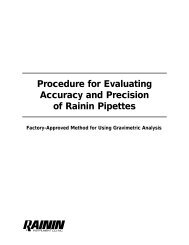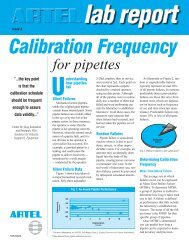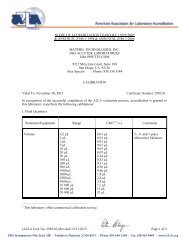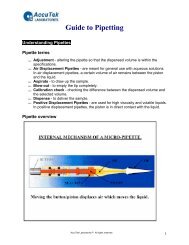Preventing contamination - Pipette.com
Preventing contamination - Pipette.com
Preventing contamination - Pipette.com
You also want an ePaper? Increase the reach of your titles
YUMPU automatically turns print PDFs into web optimized ePapers that Google loves.
<strong>Preventing</strong><br />
<strong>contamination</strong><br />
Avoidance of <strong>contamination</strong> in<br />
the laboratory requires the use of<br />
strict precautions. Among these<br />
are de<strong>contamination</strong> of pipettors,<br />
wearing gloves and choosing an<br />
appropriate pipette tip.<br />
The importance of these precautions<br />
is evident when we consider the<br />
extreme sensitivity of modern<br />
techniques such as PCR, which<br />
allows detection of a single molecule.<br />
We must also bear in mind the<br />
dangers of radioactivity and the risk<br />
of personal <strong>contamination</strong> from a<br />
pathogenic micro-organism.<br />
Personal exposure<br />
Prevention<br />
• Wear a lab coat.<br />
• Wear gloves.<br />
• Wear protective glasses.<br />
• Wear a mask.<br />
• Wipe work bench before and<br />
after with an appropriate cleaner<br />
for your application<br />
(cell culture, radio-active<br />
<strong>com</strong>ponents, pathogenic<br />
samples…).<br />
• Work under hood.<br />
• Work behind a radioactivity<br />
shield.<br />
• Avoid touching used tips.<br />
• Use unbreakable capillaries and<br />
pistons.
Types of <strong>contamination</strong> and how to prevent them<br />
<strong>Pipette</strong>-to-sample<br />
Contaminated tips or a<br />
contaminated pipette will, in turn,<br />
contaminate samples.<br />
Prevention<br />
• Use sterilized tips and clean<br />
or autoclave the parts of your<br />
pipette which are in contact<br />
with the sample.<br />
• Change the tip after each<br />
sample.<br />
Sample-to-pipette<br />
Contamination can occur if the<br />
sample or aerosols from the<br />
sample are allowed to enter the<br />
body of the pipette.<br />
Prevention<br />
• To prevent liquids from running<br />
into the pipette body, avoid<br />
inclining your pipette excessively<br />
and always store the instrument<br />
vertically.<br />
• Release the push-button slowly.<br />
Sample-to-sample<br />
(also known as sample<br />
carry-over)<br />
A portion of sample A can adhere<br />
to the inside wall of the tip after<br />
sample delivery. The left-over<br />
portion of sample A can mix with<br />
the next sample (B) and may<br />
cause a false test result.<br />
Prevention<br />
Change the tip after each sample.<br />
Pipetman<br />
with<br />
standard tip<br />
Pipetman<br />
with<br />
filter tip<br />
Microman<br />
with<br />
capillary<br />
and piston<br />
• To prevent aerosol<br />
<strong>contamination</strong>, use filter tips<br />
with Pipetman or choose a<br />
Microman positive-displacement<br />
pipette with built-in aerosol<br />
barrier.<br />
Sample carry-over<br />
protected<br />
air space<br />
Filter<br />
aerosol<br />
barrier<br />
Piston<br />
seal<br />
non-protected<br />
air space<br />
(aerosol)<br />
left-over<br />
sample A<br />
inside<br />
the tip<br />
Contamination<br />
of sample B<br />
Risk of aerosol<br />
<strong>contamination</strong><br />
No risk of aerosol<br />
<strong>contamination</strong>







